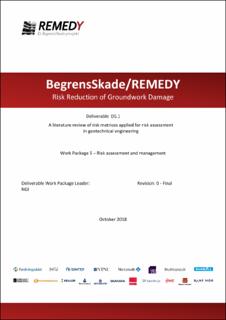| dc.contributor.author | Lin, Cungang | |
| dc.date.accessioned | 2024-01-07T19:55:27Z | |
| dc.date.available | 2024-01-07T19:55:27Z | |
| dc.date.issued | 2018-10-25 | |
| dc.identifier.uri | https://hdl.handle.net/11250/3110277 | |
| dc.description.abstract | Risk matrices are frequently used for risk assessment in all kinds of areas. This study makes a simple literature review on their applications in different fields of geotechnical engineering with focus on their size and risk classifications. It is found that the 5×5 risk matrices with 3 or 4 risk levels are most commonly used. For risk assessment on tunnels, the 5×5 risk matrices with 4 risk levels are recommended, and the risk matrix given by the International Tunnelling Association (ITA) can be used as a typical example. For risk assessment on other fields, the 5×5 risk matrices with 3 or 4 risk levels are recommended. However, no typical example is available regarding to their detailed patterns. | en_US |
| dc.description.sponsorship | Norges Forskningsråd
The Research Council of Norway | en_US |
| dc.language.iso | eng | en_US |
| dc.publisher | NGI - Norges Geotekniske Institutt | en_US |
| dc.relation.ispartofseries | NGI-rapport;20170774-D5.1 | |
| dc.title | A literature review of risk matrices applied for risk assessment in geotechnical engineering | en_US |
| dc.title.alternative | Deliverable D5.1. Work Package 5 – Risk assessment and management | en_US |
| dc.type | Research report | en_US |
| dc.source.pagenumber | 27 | en_US |
| dc.relation.project | Norges forskningsråd: 267674 | en_US |
| dc.relation.project | BegrensSkade / REMEDY | en_US |
| dc.relation.project | Risk Reduction of Groundwork Damage | en_US |
